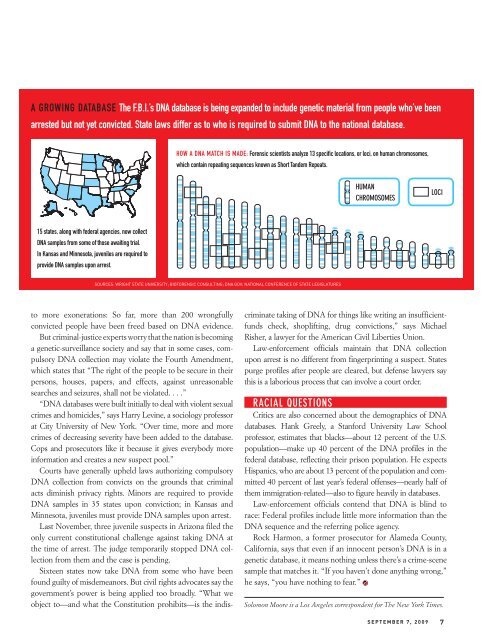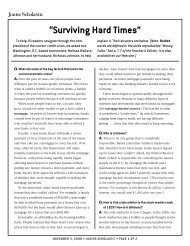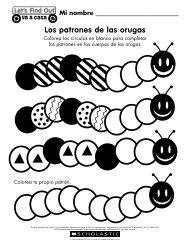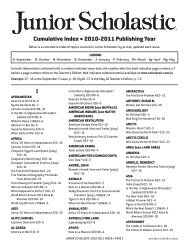3billion - Scholastic
3billion - Scholastic
3billion - Scholastic
Create successful ePaper yourself
Turn your PDF publications into a flip-book with our unique Google optimized e-Paper software.
A gRowiNg DAtABASe the F.B.i.’s DNA database is being expanded to include genetic material from people who’ve been<br />
arrested but not yet convicted. State laws differ as to who is required to submit DNA to the national database.<br />
15 states, along with federal agencies, now collect<br />
DNA samples from some of those awaiting trial.<br />
in Kansas and Minnesota, juveniles are required to<br />
provide DNA samples upon arrest.<br />
to more exonerations: So far, more than 200 wrongfully<br />
convicted people have been freed based on DNA evidence.<br />
But criminal-justice experts worry that the nation is becoming<br />
a genetic-surveillance society and say that in some cases, compulsory<br />
DNA collection may violate the Fourth Amendment,<br />
which states that “The right of the people to be secure in their<br />
persons, houses, papers, and effects, against unreasonable<br />
searches and seizures, shall not be violated. . . .”<br />
“DNA databases were built initially to deal with violent sexual<br />
crimes and homicides,” says Harry Levine, a sociology professor<br />
at City University of New York. “Over time, more and more<br />
crimes of decreasing severity have been added to the database.<br />
Cops and prosecutors like it because it gives everybody more<br />
information and creates a new suspect pool.”<br />
Courts have generally upheld laws authorizing compulsory<br />
DNA collection from convicts on the grounds that criminal<br />
acts diminish privacy rights. Minors are required to provide<br />
DNA samples in 35 states upon conviction; in Kansas and<br />
Minnesota, juveniles must provide DNA samples upon arrest.<br />
Last November, three juvenile suspects in Arizona filed the<br />
only current constitutional challenge against taking DNA at<br />
the time of arrest. The judge temporarily stopped DNA collection<br />
from them and the case is pending.<br />
Sixteen states now take DNA from some who have been<br />
found guilty of misdemeanors. But civil rights advocates say the<br />
government’s power is being applied too broadly. “What we<br />
Am ad<br />
Am ad estisi<br />
Am ad estisi<br />
How A DNA MAtcH iS MADe: Forensic scientists analyze 13 specific estisi blam locations, or loci, blam on incipit. human Xer chromosomes,<br />
blam incipit.<br />
which contain repeating sequences known as Short tandem Repeats. incipitXer sed molobor<br />
Xer sed<br />
sed molobor aliquis sequism<br />
molobor aliquis<br />
aliquis Human odipsum<br />
sequism loci<br />
sequism cHromosomes<br />
odipsum<br />
odipsum<br />
SourceS: Wright State univerSity; BioForenSic conSulting; dna.gov; national conFerence oF State legiSlatureS<br />
Am ad estisi blam incipit. Xer sed molobor aliquis sequism odipsum<br />
criminate taking of DNA for things like writing an insufficient-<br />
funds check, shoplifting, drug convictions,” says Michael<br />
Risher, a lawyer for the American Civil Liberties Union.<br />
Law-enforcement officials maintain that DNA collection<br />
upon arrest is no different from fingerprinting a suspect. States<br />
purge profiles after people are cleared, but defense lawyers say<br />
this is a laborious process that can involve a court order.<br />
racial questions<br />
Critics are also concerned about the demographics of DNA<br />
databases. Hank Greely, a Stanford University Law School<br />
professor, estimates that blacks—about 12 percent of the U.S.<br />
population—make up 40 percent of the DNA profiles in the<br />
federal database, reflecting their prison population. He expects<br />
Hispanics, who are about 13 percent of the population and committed<br />
40 percent of last year’s federal offenses—nearly half of<br />
them immigration-related—also to figure heavily in databases.<br />
Law-enforcement officials contend that DNA is blind to<br />
race: Federal profiles include little more information than the<br />
DNA sequence and the referring police agency.<br />
Rock Harmon, a former prosecutor for Alameda County,<br />
California, says that even if an innocent person’s DNA is in a<br />
genetic database, it means nothing unless there’s a crime-scene<br />
sample that matches it. “If you haven’t done anything wrong,”<br />
he says, “you have nothing to fear.”<br />
object to—and what the Constitution prohibits—is the indis- Solomon Moore is a Los Angeles correspondent for The New York Times.<br />
September 7, 2009 7

















